The Permanent Mandibular Incisors
There are four mandibular incisors; two central incisors and two lateral incisors. The mandibular central incisors are present on either side of the midline and the lateral incisors are distal to the central incisors.
Table of Contents
Salient Features Of Mandibular Incisors
- The mandibular incisors are smaller than other teeth in the permanent dentition.
- The mandibular central incisor is smaller than the lateral incisor in dimension.
- The central and lateral incisors are similar in morphology and have smooth crown surfaces.
- The contact areas are within the incisal third and almost at the same level.
Read And Learn More: Oral Anatomy Notes
The Permanent Mandibular Central Incisor
- The mesial surfaces of the mandibular central incisors are in contact with each other.
- The mesiodistal diameter of the crown is slightly more than half the diameter of the maxillary central incisor.
- The crown and root are wide labiolingually; the root is narrow mesiodistally just as the crown.
- The morphology of this tooth will be described from the labial, lingual, mesial, distal and incisal aspects.
- The nomenclature, chronology and the measurement of the maxillary central incisor are given in tables.
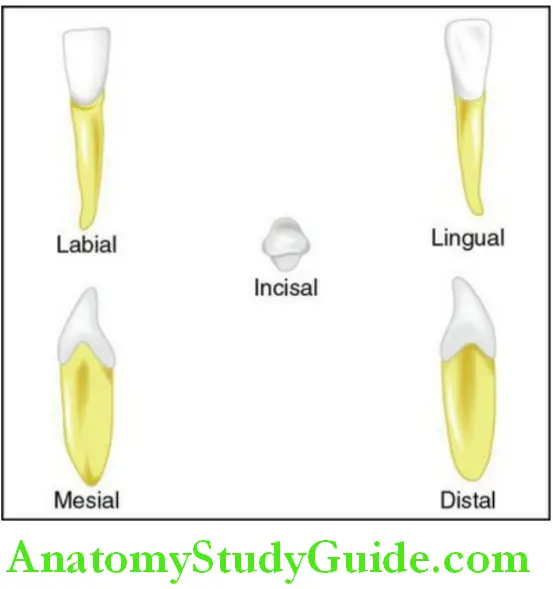
Nomenclature: Mandibular central incisor:

Mandibular central incisor: Chronology and measurements:

Labial aspect:
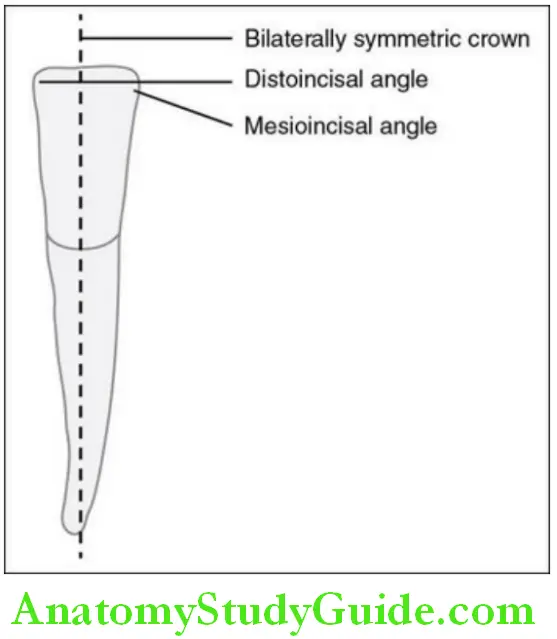
Feature of the crown:
Shape and surface:
- Shape of the crown is trapezoidal; it is bilaterally symmetrical.
- The surface is smooth and flat in the incisal third; the middle third is Convex.
Mesial and distal outline:
- The mesial and distal outlines drop from the mesioincisal and Distoincisal angle to the contact areas to a narrow cervical region.
- The mesial and distal contact areas are located within the incisal onethird and nearer to the incisal line angles.
Incisal outline:
- The incisal ridge is straight and at right angles to the long axis of the tooth.
- Sharp mesioincisal and distoincisal line angles are seen.
Cervical line:
- The cervical line is semicircular and curved towards the root.
Features of the root:
- The mesial and distal outlines of the root are in line with that of the crown till the apical one third and terminating in a pointed apex.
- The apex might be distally curved.
Lingual aspect:

Features of the crown:
Shape and surface:
- The tooth is bilaterally symmetrical.
- Surface is smooth with a slight concavity in the incisal third; it becomes convex in the cervical third due to the cingulum.
- Lingual convergence is seen.
- No developmental lines in relation to the cingulum are seen.
Cingulum:
- It is present in the cervical third.
Lingual fossa and marginal ridges:
- The lingual fossa is a small concavity in the incisal third; the marginal ridges that form the boundaries are more prominent in some cases.
Features of the root:
- The root tapers lingually along the entire length; lingual convergence is also seen.
Mesial aspect:
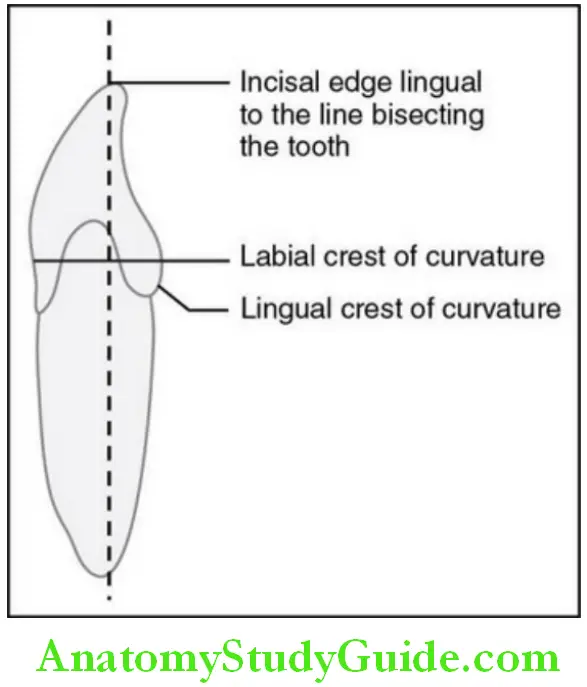
Features of the crown
Shape and surface:
- The crown is wedge shaped or triangular.
- The surface is
- Smooth and convex in the incisal third
- Flat and broad in the middle third with a tendency to be concave from the middle third to the cervical third
Labial and lingual outline:
- The labial outline is convex in the cervical third and then slopes rapidly to the incisal ridge.
- The labial crest of curvature is located in the cervical third.
- The lingual outline is convex in the cervical third, concave in the Middle third and then straightens to join the rounded narrow incisal ridge.
- The lingual crest of curvature is located in the cervical one third.
Incisal ridge:
- The incisal ridge is lingual to the centre of the root.
- It is rounded; if worn out then it becomes flat.
Cervical line:
- The cervical line is curved towards the incisal ridge up to one-third the length of the crown.
Features of the root:
- The mesial and distal outlines are in line with the outline of the crown till the middle third of the root; it tapers from the middle third through the apical third ending in a rounded or pointed apex.
- The surface is flat with broad developmental depressions along the length of the root.
Distal aspect:
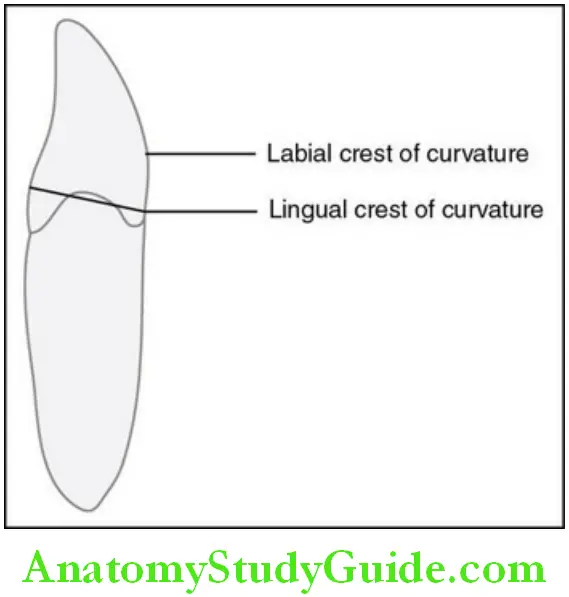
The distal aspect is similar to the mesial aspect except the following differences:
- The cervical line is less curved than on the mesial aspect.
- The developmental depressions on the root are more marked and a deep Developmental groove may be seen in the centre of the depression.
Incisal aspect :
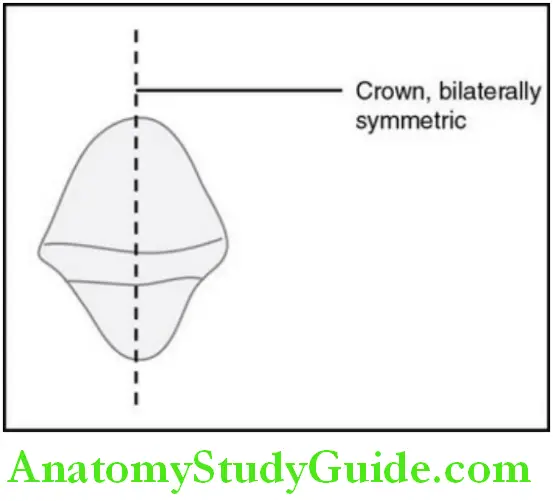
- The crown is bilaterally symmetrical, i.e. The mesial half is identical to the distal half.
- This feature of the tooth makes the differentiation between the left and right mandibular central incisors a tough task.
- The labiolingual dimension is more than the mesiodistal dimension.
- The incisal edge is perpendicular to the line bisecting the crown in a labiolingual direction.
- The mesiodistal dimension of the crown is wider labially than lingually.
- More of the labial surface is seen.
- Labial surface of the crown – flat in the incisal third with a tendency to be convex in the cervical third.
- Lingual surface of the crown – concave in the incisal third and convex in the cervical third.
- The features that can help in identification of the mandibular central incisor are given in box.
Features to identify the mandib ular central incisor:
- Bilaterally symmetrical crown
- Sharp mesioincisal and distoincisal line angles
- Incisal ridge at right angles to the long axis of the crown buccolingually from the labial aspect
- Contact areas at the same level within the incisal third
Differentiation Between The Right And Left Mandibular Central Incisor
It is difficult to differentiate between the right and left mandibular central incisor as the tooth is bilaterally symmetrical.
- The curvature of the cervical line may be helpful in identification.
- Root might exhibit a distal tilt.
Development and landmarks: Crown and root of the mandibular central incisor
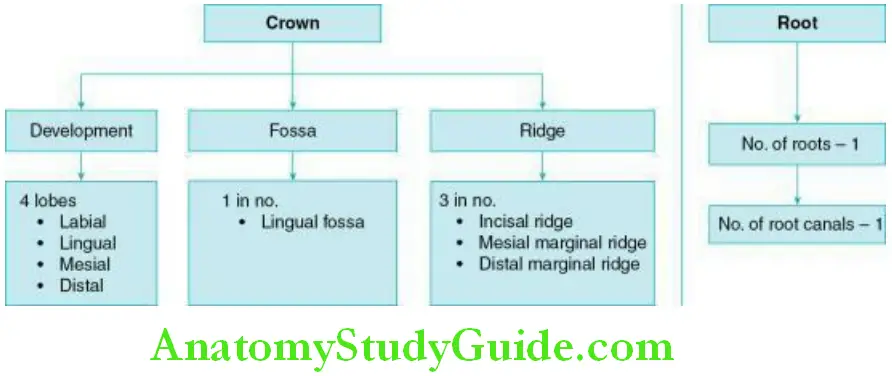
Variations And Developmental Anomalies
- Fusion – it is the due to the union of two separate tooth germs. This may be exhibited by the mandibular central incisor.
- Gemination – it is the division of one tooth bud into two.
- Root bifurcation
The Permanent Mandibular Incisors Synopsis
Labial aspect:
Crown:
- Shape of the crown is trapezoidal; it is bilaterally symmetrical.
- The mesial and distal contact areas are located within the incisal one-third and nearer to the incisal line angles.
- The incisal ridge is straight and at right angles to the long axis of the tooth.
- Sharp mesioincisal and distoincisal line angles are seen.
Root:
- The mesial and distal outlines of the root are in line with that of the crown till the apical one-third and terminating in a pointed apex.
Lingual aspect:
Crown:
- The tooth is bilaterally symmetrical.
- Surface is smooth with a concavity in the incisal third; it becomes convex in the cervical third due to the cingulum.
- Lingual convergence is seen.
- Cingulum is present in the cervical third.
- The lingual fossa is a small concavity in the incisal third; the marginal ridges that form the boundaries are not prominent.
Root:
- The root tapers lingually along the entire length; lingual convergence is also seen.
Mesial aspect:
Crown:
- The crown is wedge shaped or triangular.
- The surface is smooth and convex in the incisal third and flat and broad in the middle third.
- The labial crest of curvature is located in the cervical third.
- The lingual crest of curvature is located in the cervical one third.
- Incisal ridge is lingual to the centre of the root.
Root:
- The mesial and distal outlines are in line with the outline of the crown till the middle third of the root.
- The root then tapers from the middle third ending in a rounded or pointed apex.
- The surface is flat with broad developmental depressions along the length of the root.
Distal aspect:
The distal aspect is similar to the mesial aspect except the following differences:
- The cervical line is less curved than on the mesial aspect.
- The developmental depressions on the root are more marked.
Incisal aspect:
- The crown is bilaterally symmetrical.
- The labiolingual dimension is more than the mesiodistal dimension.
- The incisal edge is perpendicular to the line bisecting the crown in a labiolingual direction.
The Permanent Mandibular Lateral Incisor
There are two mandibular lateral incisors; one in each quadrant present distal to the mandibular central incisor.
- They resemble the central incisor but are larger in dimension than the central incisor.
- They are not bilaterally symmetrical.
- The crowns appear to be twisted on the root base to accommodate themselves to the curvature of the arch.
- This may be termed as the distolingual twist of the crown.
- The morphology of this tooth will be described from the labial, lingual, mesial, distal and incisal aspects.
- The nomenclature, chronology and the measurement of the maxillary central incisor are given in tables.

Nomenclature: Mandibular lateral incisor:

Mandibular lateral incisor: Chronology and measurements:
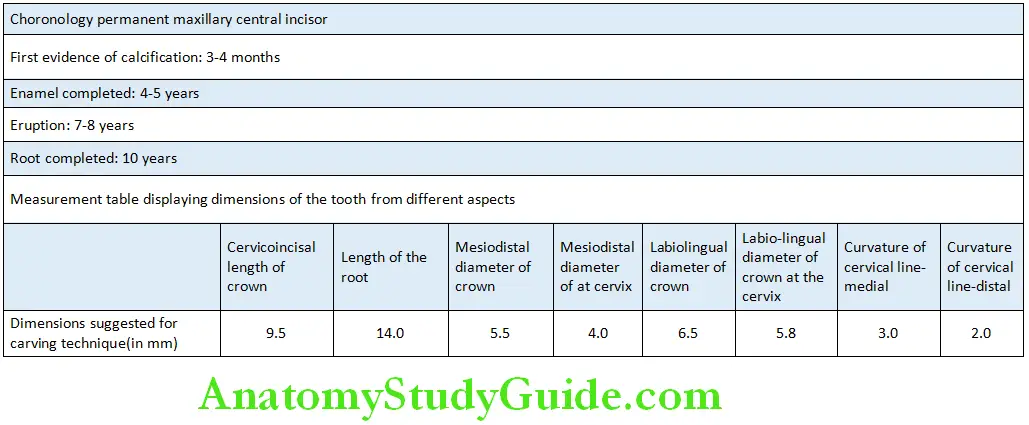
Labial aspect:
Features of the crown:
It is similar to the mandibular central incisor
Shape and surface:
- Shape of the crown is trapezoidal
- The surface is smooth and flat in the incisal third; the middle third is Convex
- The crown is wider mesiodistally by approximately 1 mm than the Mandibular central incisor.
Mesial and distal outline:
- The mesial and distal outlines drop from the mesioincisal and
Distoincisal angle to the contact areas and further to a narrow cervical Region. - The mesial contact area is located close to the mesioincisal line angle
- The distal contact area is within the incisal third but more cervical to the mesial contact area.
- It is within the incisal third to make contact With the mesial contact area of the canine.
Incisal outline:
- Generally the distoincisal line angle is more rounded than the mesioincisal angle.
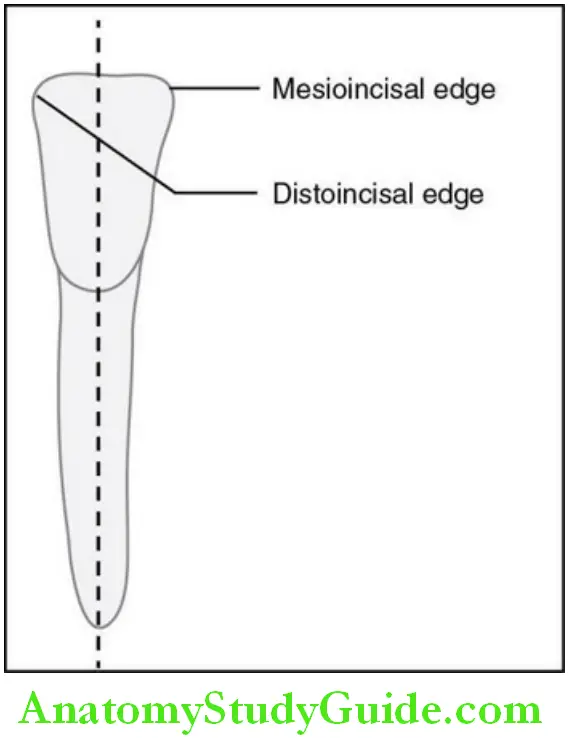
Feature of the root:
- The root is cone-shaped with a blunt apex.
- It might exhibit a distal tilt.
Lingual aspect:
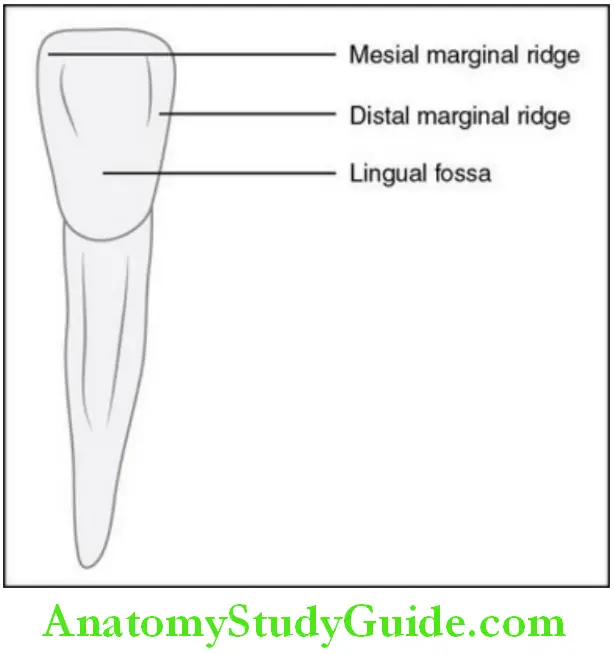
Features of the crown:
- The shape, surface and outlines of the crown are similar to the Mandibular central incisor.
- Lingual convergence is seen.
- The cingulum is present within the cervical third of the crown which is Confluent with the mesial and distal marginal ridges.
- The cingulum and marginal ridges are more prominent thus making the lingual fossa appear more marked.
Features of the root:
- The root tapers lingually along the entire length and exhibits lingual Convergence.
Mesial aspect:
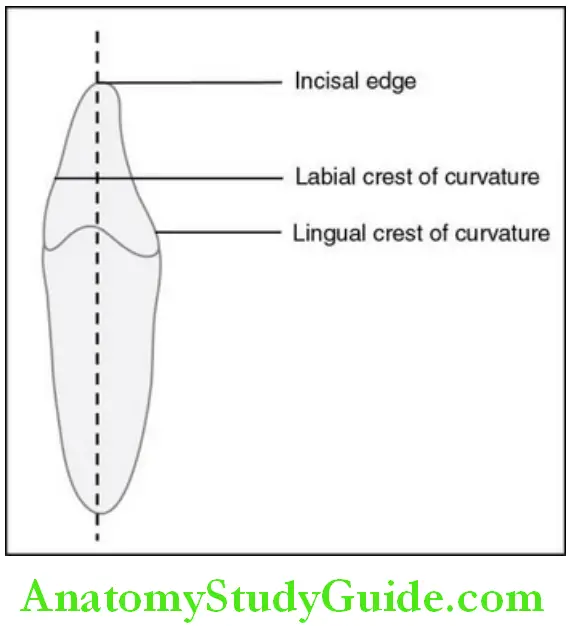
The crown of the mandibular incisor is similar to the mandibular central incisor and differs only in size
Shape and surface:
- The crown is wedge shaped or triangular.
- The surface is smooth and convex in the incisal third and flat and Broad in the middle third with a tendency to be concave from the Middle third to the cervical third.
Labial and lingual outline:
- The labial outline is convex in the cervical third and then slopes rapidly To the incisal ridge; the labial crest of curvature is located in the cervical third.
- The lingual outline is convex in the cervical third, concave in the Middle third and then straightens to join the rounded narrow incisal Ridge; the lingual crest of curvature is located in the cervical one-third.
Incisal ridge:
- It is lingual to the centre of the root.
- It is rounded; if worn out then it is flat.
Cervical line:
It is curved towards the incisal ridge up to one-third the length of the
Crown.
Features of the root:
- The mesial and distal outlines are in line with the outline of the crown till the middle third of the root; the root then tapers from the middle third to the apical third ending in a rounded or pointed apex.
- The surface is flat with broad developmental depressions along the length of the root.
Distal aspect:
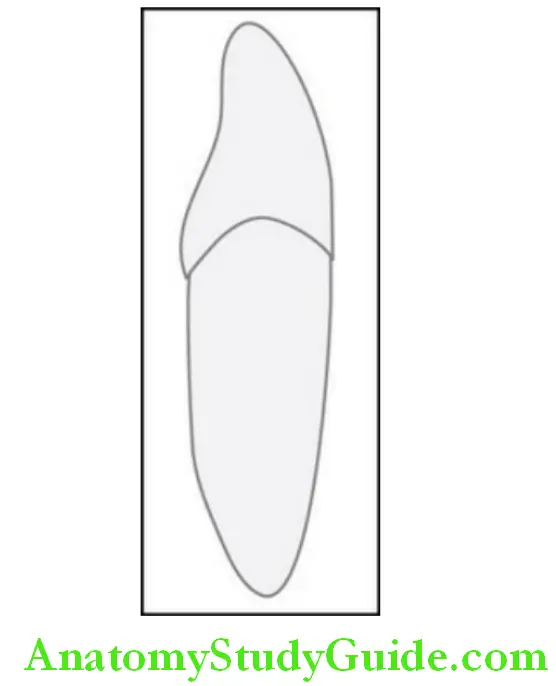
The distal aspect is similar to the mesial aspect except for the following differences:
- Deeper concavity above the cervical line on the distal surface.
- The distal half of the crown appears to be more lingually inclined due to the distolingual twist of the crown.
- The root is longer than that of the mandibular central incisor.
Incisal aspect:

- The incisal edge is not perpendicular to the line bisecting the crown and root labiolingually as in the mandibular central incisor.
- The incisal edge follows the curvature of the mandibular arch and thus appears to be twisted on the root base (distolingual twist).
- The crown is wider labiolingually than mesiodistally.
- The crown is not bilaterally symmetrical.
- More of the labial surface is seen as the incisal edge is lingually placed.
- The root axes of the mandibular central incisor and lateral incisor are parallel to each other in the alveolar process even though the incisal ridges are not in line.
- The features that can help in the identification of the mandibular lateral incisor are given in the box.
Features to identify the mandibular lateral incisor:
- The crown is not bilaterally symmetrical
- Slightly rounded distoincisal line angle and sharp mesioincisal line angle
- Incisal ridge is not perpendicular to the line bisecting the crown labiolingually
- Distolingual twist
Differentiation between right and left mandibular lateral incisor:
- Sharp mesioincisal angle
- Rounded distoincisal angle
- Distolingual twist
Development And Landmarks Crown And Root Of The Mandibular Lateral Incisor

Variations and developmental anomalies
- The root may contain two canals.
- Root may be bifurcated labiolingually.
The Permanent Mandibular Incisors Synopsis
Labial aspect:
Crown:
- The shape of the crown is trapezoidal.
- The crown is wider mesiodistally by approximately 1 mm.
- The mesial contact area is located close to the mesioincisal line angle.
- The distal contact area is within the incisal third but more cervical to the mesial contact area.
- It is within the incisal third to make contact with the mesial contact area of the canine.
Root:
- It is cone-shaped with a blunt apex; it might exhibit a distal tilt.
Lingual aspect:
Crown:
- The shape, surface and outlines of the crown are similar to the mandibular
Central incisor. - The cingulum and marginal ridges are more prominent thus making the lingual Fossa appear more marked.
Mesial aspect:
The crown of the mandibular lateral incisor is similar to the mandibular central incisor and differs only in size.
- The crown is wedge-shaped or triangular.
- The labial crest of curvature is located in the cervical third.
- The lingual crest of curvature is located in the cervical one-third.
- The incisal ridge is lingual to the centre of the root
Distal aspect:
The distal aspect is similar to the mesial aspect except for the following differences:
- The distal half of the crown appears to be more lingually inclined due to the Distolingual twist of the crown.
Incisal aspect:
- The crown is wider labiolingually than mesiodistally; it is not bilaterally Symmetrical.
- The incisal edge follows the curvature of the mandibular arch and thus appears to be twisted on the root base (distolingual twist).
- More of the labial surface is seen as the incisal edge is lingually placed.
Major Differences That Distinguish Maxillary From Mandibular Incisors (Arch Traits)
Differences between the maxillary and mandibular incisors:
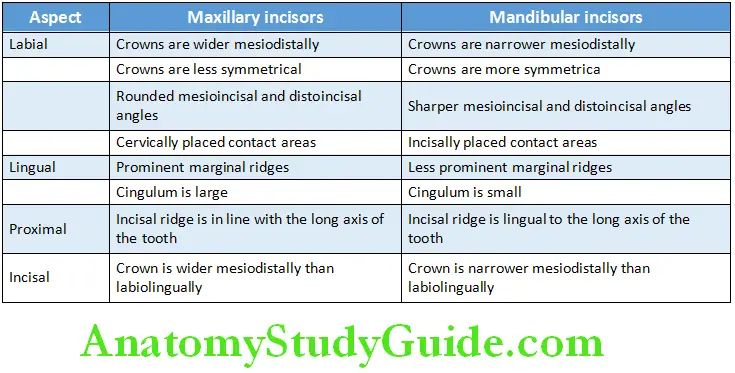
Leave a Reply